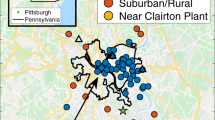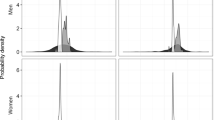Abstract
Although short in duration, air pollutant exposures occurring in non-residential microenvironments (MEs), including restaurants, vehicles and commercial locations, can represent a large fraction of total personal exposures. For the Sources and Composition of Particulate Exposures study, a novel compact sampling system was developed, facilitating simultaneous measurement of highly speciated PM2.5 mass in a range of commercial and residential locations. This sampler also included 1-min measurements of PM2.5 mass and ultrafine particle (UFP) counts. Sampling was conducted in a number of MEs (retail stores, restaurants and vehicles) throughout Atlanta. Chemically resolved particulate measurements in these locations are of interest for both exposure scientists and epidemiologists but have typically not been conducted because of logistical constraints associated with sampling these trace constituents. We present measurements from a non-random sample of locations that are limited in their generalizability but provide several promising hypothesis-generating results. PM2.5 mass concentrations greater than 100 μg/m3, and UFPs>105 particles /cm3 were measured during several events in the restaurant and vehicle. Somewhat unexpectedly, the grocery store ME, along with the restaurant and vehicle, also had the highest levels of elemental carbon (EC), organic carbon (OC) and most elements. In-vehicle concentrations of soil-related elements (Al, Ca, Fe, K and Ti) and auto-related elements (EC, OC, Zn and Cu) were higher than those measured at a central ambient site. The lowest concentrations for most pollutants were found in the hospital and retail locations. It is questionable whether periodic, high PM concentrations in the grocery store and restaurant pose health risks for customers; however, individuals working in these locations may be exposed to levels of concern.
This is a preview of subscription content, access via your institution
Access options
Subscribe to this journal
Receive 6 print issues and online access
$259.00 per year
only $43.17 per issue
Buy this article
- Purchase on Springer Link
- Instant access to full article PDF
Prices may be subject to local taxes which are calculated during checkout







Similar content being viewed by others
References
Adams H., Nieuwenhuijsen M., and Colvile R. Determinants of fine particle (PM2.5) personal exposure levels in transport microenvironments, London, UK. Atmos Environ 2001: 35 (27): 4557–4566.
Brauer M., and ‘t Mannetje A. Restaurant smoking restrictions and environmental tobacco smoke exposure. Am J Public Health 1998: 88 (12): 1834–1836.
Brown K., Sarnat J., Suh H., Coull B., Spengler J., and Koutrakis P. Ambient site, home outdoor and home indoor particulate concentrations as proxies of personal exposures. J Environ Monit 2008: 10 (9): 1041–1051.
Chang L., Koutrakis P., Catalano P., and Suh H. Hourly personal exposures to fine particles and gaseous pollutants: results from Baltimore, Maryland. J Air Waste Manage Assoc 2000: 50 (7): 1223–1235.
Chow J., and Watson J. Guideline on Speciated Particulate Monitoring. Draft 3, prepared for US EPA by the Desert Research Institute, 1998.
Fruin S., Winer A., and Rodes C. Black carbon concentrations in California vehicles and estimation of in-vehicle diesel exhaust particulate matter exposures. Atmos Environ 2004: 38 (25): 4123–4133.
Gent J., Koutrakis K., Belanger K., Triche E., Holford T., and Bracken M., et al. Symptoms and medication use in children with asthma and traffic-related sources of fine particle pollution. Environ Health Perspect 2009: 117 (7): 1168–1174.
Hansen D., Edgerton E., Hartsell B., Jansen J., Burge H., and Koutrakis P., et al. Air quality measurements for ARIES. J Air Waste Manage Assoc 2006: 56 (10): 1445–1458.
Hjortenkrans D., Bergback B., and Haggerud A. Metal emissions from brake linings and tires: case studies of Stockholm, Sweden 1995/1998 and 2005. Environ Sci Technol 2007: 41 (15): 5224–5230.
Kinney P., Aggarwal M., Northridge M., Janssen N., and Shepard P. Airborne concentrations of PM(2.5) and diesel exhaust particles on Harlem sidewalks: a community-based pilot study. Environ Health Perspect 2000: 108 (3): 213–218.
Koutrakis P., Brauer M., Briggs S., and Leaderer B. Indoor exposures to fine aerosols and acid gases. Environ Health Perspect 1991: 95: 23–28.
Legret M., and Pagotto C. Evaluation of pollutant loadings in the runoff waters from a major rural highway. Sci Total Environ 1999: 235: 143–150.
Levy J., Bennett D., Melly S., and Spengler J. Influence of traffic patterns on particulate matter and polycyclic aromatic hydrocarbon concentrations in Roxbury, Massachusetts. J Expos Anal Environ Epidemiol 2003: 13 (5): 364–371.
Levy J., Dumyahn T., and Spengler J. Particulate matter and polycyclic aromatic hydrocarbon concentrations in indoor and outdoor microenvironments in Boston, Massachusetts. J Expos Anal Environ Epidemiol 2002: 12 (2): 104–114.
Long C., and Sarnat J. Indoor-outdoor relationships and infiltration behavior of elemental components of outdoor PM2.5 for Boston-area homes. Aerosol Sci Technol 2004: 38: 91–104.
NCDC. Climatography of the United States, No. 81, Monthly Station Normals of Temperature, Precipitation, and Heating and Cooling Degree Days, 1971–2000. In: National Climatic Data Center N.O.a.A.A. (Ed.). National Environmental Satellite, Data and Information Service: Asheville, NC, 2002.
Ott W., Switzer P., and Robinson R. Particle concentrations inside a tavern before and after prohibition of smoking: evaluating the performance of an indoor air quality model. J Air Waste Manage Assoc 1996: 46: 1120–1134.
Rea A., Zufall M., Williams R., Sheldon L., and Howard-Reed C. The influence of human activity patterns on personal PM exposure: a comparative analysis of filter-based and continuous particle measurements. J Air Waste Manage Assoc 2001: 51 (9): 1271–1279.
Repace J., and Lowrey A. Indoor air pollution, tobacco smoke, and public health. Science 1980: 208 (4443): 464–472.
Riediker M., Williams R., Devlin R., Griggs T., and Bromberg P. Exposure to particulate matter, volatile organic compounds, and other air pollutants inside patrol cars. Environ Sci Technol 2003: 37 (10): 2084–2093.
Rodes C., Sheldon L., Whitaker D., Clayton A., Fitzgerald K., and Flanagan J., et al. Measuring Concentrations of Selected Air Pollutants Inside California Vehicles (Final Report). California Environmental Protection Agency, Air Resources Board: Sacramento, CA, 1998.
Sarnat J., Long C., Koutrakis P., Coull B., Schwartz J., and Suh H. Using sulfur as a tracer of outdoor fine particulate matter. Environ Sci Technol 2002: 36: 5305–5314.
Sarnat J., Marmur A., Kim E., Russell A., Sarnat S., and Mulholland J., et al. Fine particle sources and cardiorespiratory morbidity: an application of chemical mass balance and factor analytical source-apportionment methods. Environ Health Perspect 2008: 116 (4): 459–466.
Sarnat S., Coull B., Schwartz J., Gold D., and Suh H. Factors affecting the association between ambient concentrations and personal exposures to particles and gases. Environ Health Perspect 2006: 114 (5): 649–654.
Schauer J., Mader B., Deminter J., Heidemann G., Bae M., and Seinfeld J., et al. ACE-Asia intercomparison of a thermal–optical method for the determination of particle–phase organic and elemental carbon. Environ Sci Technol 2003: 37 (5): 993–1001.
Szymczak W., Menzel N., and Keck L. Emission of ultrafine copper particles by universal motors controlled by phase angle modulation. J Aerosol Sci 2007: 38: 520–531.
Tsang A., and Klepeis N. Descriptive Statistics Tables from a Detailed Analysis of the National Human Activity Pattern Survey (NHAPS) Data. United States Environmental Protection Agency, Office of Research and Development: Washington, DC, 1996.
Turner W., Olson B., and Allen G. Calibration of sharp cut impactors for indoor and outdoor particle sampling. J Air Waste Manage Assoc 2000: 50: 484–487.
Wallace L., Williams R., Rea A., and Croghan C. Continuous weeklong measurements of personal exposures and indoor concentrations of fine particles for 37 health-impaired North Carolina residents for up to four seasons. Atmos Environ 2006: 40 (3): 399–414.
Zhu Y., Hinds W., Kim S., Shen S., and Sioutas C. Study of ultrafine particles near a major highway with heavy-duty diesel traffic. Atmos Environ 2002: 36 (27): 4323–4335.
Acknowledgements
This project was funded by the Electric Power Research Institute (contract no. EP-P11389/C5672). We appreciate the guidance provided by Ron Wyzga. We thank Jamie Schauer, Jeff DeMinter, Denise Lamoureux and Jose Vallarino.
Author information
Authors and Affiliations
Corresponding author
Ethics declarations
Competing interests
The authors declare no conflict of interest.
Additional information
Supplementary Information accompanies the paper on the Journal of Exposure Science and Environmental Epidemiology website
Supplementary information
Rights and permissions
About this article
Cite this article
Brown, K., Sarnat, J. & Koutrakis, P. Concentrations of PM2.5 mass and components in residential and non-residential indoor microenvironments: The Sources and Composition of Particulate Exposures study. J Expo Sci Environ Epidemiol 22, 161–172 (2012). https://doi.org/10.1038/jes.2011.41
Received:
Accepted:
Published:
Issue Date:
DOI: https://doi.org/10.1038/jes.2011.41
Keywords
This article is cited by
-
Evaluation of characterization and filtration performance of air cleaner materials
International Journal of Environmental Science and Technology (2021)
-
A framework for estimating the US mortality burden of fine particulate matter exposure attributable to indoor and outdoor microenvironments
Journal of Exposure Science & Environmental Epidemiology (2020)
-
Sources of indoor air pollution in New York City residences of asthmatic children
Journal of Exposure Science & Environmental Epidemiology (2014)
-
Trace metals in size-fractionated particulate matter in a Portuguese hospital: exposure risks assessment and comparisons with other countries
Environmental Science and Pollution Research (2014)



